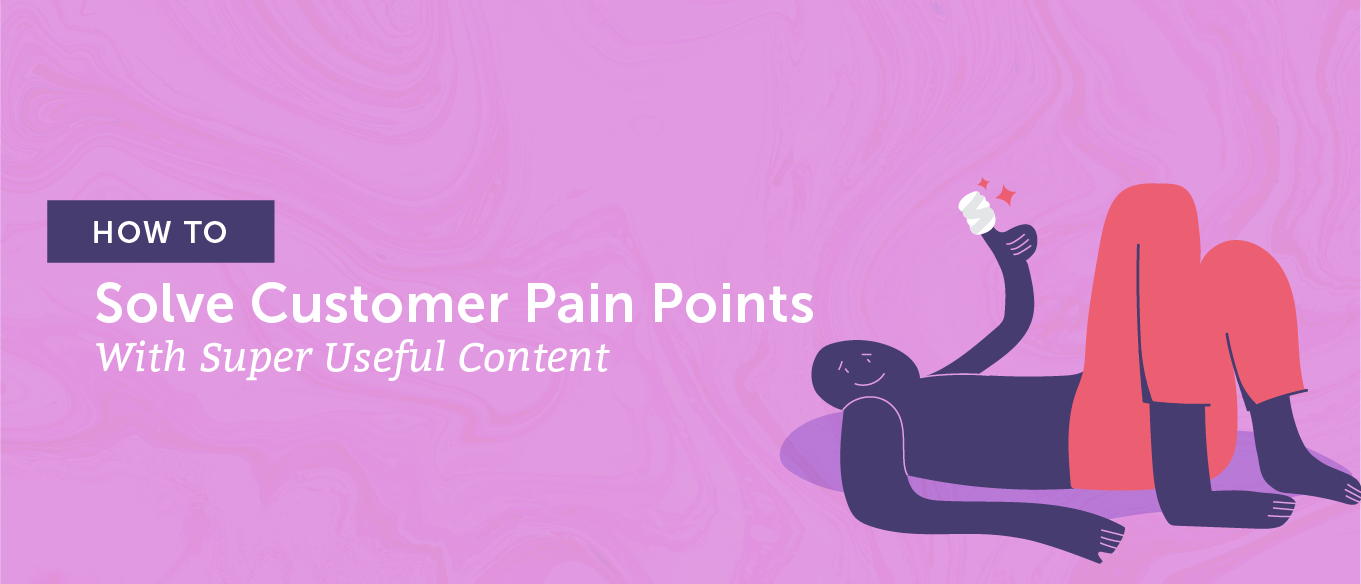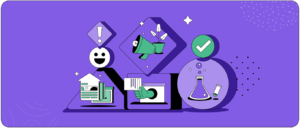In the content marketing biz, we have so much to think about when it comes to strategy and creation. There are tactics, formats, headlines, SEO, creation channels, distribution channels, calls to action, funnels, monitoring… the list goes on.
It can be overwhelming.
Really, there’s only one thing that should be at the forefront of your mind: the customer. Follow my lead, and all of the other stuff will come together a lot easier.
Your goal should always be to create useful content that helps customers and/or makes their lives simpler; it will produce better results.
Here’s everything you need to know about putting the customer and their pain points at the center of your content strategy.
[Tweet “How to solve customer pain points with super useful content.”]
Download Your Own Content Matrix Template
We understand that mapping out the pain points of your customers can be a hassle. With this content matrix template, all you have to do is place customers in their respective stage of the customer journey and list out their needs in the columns to follow.
It’s super simple to use, and it’s great for keeping the wants and needs of your customers in line.
Download it now, and then we can talk about customer pain points.
[content_upgrade_shortcode]
Table of Contents
- What Are Customer Pain Points?
- Why Solve Customer Pain Points With Content?
- The Four Types of Customer Pain Points
- How to Find Customer Pain Points
- How to Map Customer Pain Points to Content Ideas
- 3 Bonus Tips for Solving Customer Pain Points With Content
What Are Customer Pain Points?
Customer pain points are issues or challenges faced by your target audience during the customer lifecycle. Knowing what these pain points are allows you to establish your brand as the authority that can help them solve their problems.
Why Solve Customer Pain Points With Content?

Here’s why you should use content backed up with some interesting data to solve customer pain points:
- Better Ranking – Google rewards useful content that meets user needs. Social algorithms also reward content that users engage with or is most relevant.
- Drive Traffic – Two of the top content marketing challenges are creating content that attracts more traffic and developing content that resonates with [their] target audience. Your audience is more likely to click on content that solves their problems than some kind of sales pitch.
- Prove That You Care – 73% of customers expect companies to understand their needs and expectations. Customer-centric content proves you value customer needs over making a sale.
- Nurture Customers – Content professionals say the number one factor contributing to the success of their content strategy is their “ability to understand and connect with the audience’s values, interests, and/or pain points.” Through useful content, you can build trust and loyalty.
Hence, content that solves customer pain points is useful across the customer lifecycle.
The Four Types of Customer Pain Points
When it’s time to identify customer pain points, it’ll help to understand the kind of things to keep an eye out for:
1. Finances
A product or solution is too expensive, you don’t have the budget to succeed, or you aren’t getting enough value for your money.
Examples: “I can’t afford to pay for a stack of different marketing tools,” or “I’d like to go organic, but it’s too expensive.”
2. Productivity
Your current situation or solution is inefficient. You feel they are wasting time.
Examples: “Posting on every single social media channel takes forever,” or “A complete skincare routine takes too much time and effort.”
3. Process
Your current systems or processes aren’t good enough, have issues, or are ineffective.
Examples: “I’m failing to get new clients,” or “I don’t know how to cook nutritious meals.”
4. Support
Customers are not receiving the support they need at important stages of their journey.
Examples: “I don’t know how to get started with this solution/product,” or “I can’t find answers to my questions.”
Though not exclusive to these four categories, the most common customer pain points tend to relate to the above.
How to Find Customer Pain Points
 Here’s how we suggest you conduct your pain point research:
Here’s how we suggest you conduct your pain point research:
1. Carry Out Customer Surveys
Ask new subscribers and existing customers to take part in a survey. Use open-ended questions to get in-depth answers, like:
- What’s the first change/purchase you’d make if you had a bigger budget?
- What frustrates you about your current method of [strategy]?
- What are the most time-consuming aspects of your job?
- What’s holding you back from improving [method]?
Create your surveys using a tool, such as Typeform or SurveyMonkey. Then, you can share it on social media or via email — along with an incentive to encourage people to take part. Here’s an example from MeUndies:
 Source: https://reallygoodemails.com/emails/help-us-improve-your-membership-experience
Source: https://reallygoodemails.com/emails/help-us-improve-your-membership-experience
Believe it or not, simply saying that you will use their insights to improve content and your product(s) is enough incentive.
Another alternative is to use a chatbot to carry out surveys or gather feedback. There are lots of chatbot platforms out there to choose from, and they work on different channels — including your site, Facebook Messenger, WhatsApp and more.
2. Do Keyword Research
The kind of things people search for, in relation to your niche, are good indicators of where their problems lie. This is particularly true for informational or question-based queries.
Go to Google, type in your main keyword, and see what questions come up in the “People also ask” box:

You can also find question-based search queries at AnswerThePublic:

You could also use your chosen SEO tool to generate related keywords and be on the lookout for information queries. Here’s an example from Ubersuggest:

These related keywords suggest that getting enough protein and finding alternatives for foods they love (i.e. honey) are major challenges.
Don’t worry too much if these queries seem to be less popular (i.e. long-tail queries). The thing is, it’s better to have fewer people that need your company’s help for their specific challenges visit your site. They are more likely to become customers in the future.
3. Visit Specialist Forums and Q&A Sites
Find frequently asked questions and trending topics on specialist forums. Simply type your keyword/industry + “forum” into Google:

Similarly, you can find relevant subreddits where people talk about their challenges or ask questions. This is from the subreddit r/Haircare, for example:

You can also browse topics, spaces, and questions on Quora. Here are the questions that pop up when you search “find a job”:

In relation to all of the above, focus on recent posts or questions to ensure pain points are still relevant to your audience.
4. Monitor Comments and Mentions
Customers talk about their challenges on many channels. For instance, they may ask further questions related to your existing content in your blog’s comment section. Here’s an example from Yoast’s blog:

You can also employ social listening to monitor conversations related to your brand or industry. Social media is a great place to see what customers really think and what they talk about. People love using social media to air their grievances and ask questions of their peers.
Reviews and testimonials may also contain pain points that you have helped customers to overcome. Here’s a review for a cybersecurity consultant:
 Source: https://clutch.co/profile/underdefense#reviews
Source: https://clutch.co/profile/underdefense#reviews
In the highlighted section, you can see that the consultant prevented their client from losing customers due to cybersecurity violations. This is a pain point they could help with for future potential customers.
The trick with all of these monitoring tactics is to make note of what comes up time and again. Then you’ll know which pain points matter most to customers.
5. Speak to Your Customer Support and Salespeople
Find out from your teams or colleagues what kind of pain points arise when they communicate with customers or leads.
[Tweet “Find out from your teams or colleagues what kind of pain points arise when they communicate with customers or leads.”]
On the sales side, discover what questions potential customers frequently ask and, more importantly, what turning points most frequently result in a purchase/sale. Let’s say you have a shipping company and leads are intrigued when they learn about your fast shipping times. Therefore, it’s reasonable to say that a customer’s pain point is slow shipping times.
As for customer support, find frequently asked questions or problems that arise for existing customers. This way you find pain points across the entire customer lifecycle — not just awareness-phase challenges.
Don’t forget to continue to research customer pain points regularly. Industries change, people change, the world changes (oh, don’t we know it!), so the circumstances which govern customer pain points may change.
How to Map Customer Pain Points to Content Ideas
Put together a list of all the pain points you found in your research. It makes sense to order that list according to the level of importance. In its raw form, this list will give you an idea of the most significant pain points you need to solve.

The next step is to take your list of pain points and carefully translate them into content ideas.
1. Create Detailed Customer Personas
The first thing you need to do is present your findings clearly in the form of customer personas. Here are the details a customer persona should include:
- Demographic information
- Psychographic information
- Goals
- Challenges/pain points
- Preferred channels/content formats
- How your solution/product helps
- Possible objections
CoSchedule has a handy audience persona template you can fill out with your corresponding information:

If you have multiple audience segments, create multiple personas.
Customer personas contain a lot of detailed insights that provide a deep understanding of your customers. Thus, they give every content creator, marketer, outside contractor, and so on, a basis to use as a model.
2. Create a Content Matrix
A content matrix is a useful way to map pain points to solutions, content ideas, content goals, and wider business objectives. Here’s a template you can use:

As you can see, the table is divided into four audience sections that span the customer lifecycle. The reason for this is that different content formats work for different stages of the customer journey.
 Source: https://www.pointvisible.com/blog/b2b-customer-lifecycle-marketing/
Source: https://www.pointvisible.com/blog/b2b-customer-lifecycle-marketing/
You’ll work across the matrix and list pain points, possible solutions to those pain points, how those solutions translate into a content idea, and how you’ll use that content asset to move the user into the next stage of the customer lifecycle.
Let’s give it a try and see what this might look like in practice. Let’s say you want to create awareness-stage content for a meditation app:

See how you move from pain point, to solution, to asset, to the next step?
As you move on to each stage of the customer lifecycle, the pain points remain the same, but the solution/content format may be different.
For instance, in the consideration stage, somebody who worries a lot may already be familiar with mindfulness, or maybe they’ve already read your beginner’s guide. Thus, they don’t need an introduction; they need a more in-depth solution.
Furthermore, in most cases, the CTA will move the audience segment to the content asset for the next stage of the life cycle. In this instance, the next, more in-depth content asset is the “free mindfulness meditation course”.

All in all, it’s a logical way to mindmap ideas, step by step. Furthermore, it allows you to relate each idea to the bigger picture (i.e. your wider content marketing strategy).
3. Create Topic Clusters
To map pain points to content ideas for your blog, another option is to create pillar posts and topic clusters. It’s one of the best content marketing strategies for improving SEO while meeting audience needs.
[Tweet “Create pillar posts and topic clusters to map customer pain points.”]
First, group related pain points under core themes. Using the above example, we may have four, core themes: “Sleep,” “Focus,” “Worry,” and “Stress”.
Create an in-depth pillar post for each of your core themes, and make sure that they cover everything your audience would like to know about that topic — including the most important related pain points and sub-topics.
For the first core theme, you might create:
- How to Sleep Better (The Complete Guide)
Then, create cluster content that is specific to individual pain points that come under your core topics. Here, these could be:
- How to Cope With Insomnia
- X Drinks That Prevent Sleep
- 10 Tips to Get to Sleep Faster
- What is Good Quality Sleep?
You can use a method similar to the content matrix to turn individual pain points into ideas.
For example:
- Problem: “I struggle with insomnia”
- Solution: Offer coping techniques
- Asset: “How to Cope With Insomnia”
Don’t forget to validate all topic ideas with keyword research.
Create an internal linking structure, in which each piece of cluster content links to its respective pillar page. This will boost the authority of your pillar pages.
Plus, what you’ll wind up with is a library of useful content that covers the core topics in their entirety. Hence, you’ll boost your site’s overall authority.
Three Bonus Tips for Solving Customer Pain Points With Content
Now that you have a grip on the strategic side of things, here’s some advice on creating content that meets your audience’s needs:
1. Choose the Most Useful Formats
The point of all this is to put your customers first, so rather than creating the type of content that you think is best or that’s the easiest to produce, think carefully about what’s actually going to be most useful for your customers.
Think about the purpose of each piece of content and which format will be most effective for that purpose. Which content format will help customers solve their pain points quickly and easily? It could be an in-depth educational blog post, an explainer video, an infographic, etc.
Furthermore, through your research, you should be able to dig deep and pinpoint exactly what type of content resonates with your audience. For example, perhaps you notice through social monitoring that your audience engages with certain types of visuals the most. Hence, you decide to give your audience what they want and make them a priority within your content strategy.
You should also supplement content with upgrades. Yes, it will help you get more email subscribers, but that’s not the only reason.
A checklist, template, cheat sheet, or something similar will be super useful for your audience in taking the next step and putting the advice in your blog post into action. Here’s an example from a Sumo post on emotional persuasion:

2. Personalize Content
If you have multiple customer personas, you’ll want to segment your audience into different groups. Then, personalize the content you share with each segment.
What’s the reason for this?
Different audience segments have different pain points. Contently, for example, has two blogs set up for their two different audience segments: content marketers and freelancers.
Naturally, their posts on each blog cover pain points catered to the respective audience. Here’s an example from The Content Strategist (for content marketers):

Here’s one from The Freelancer (for freelancers):

Both posts cover COVID-related pain points but for very different audience segments.
That’s not to say you have to create two separate blogs; just be sure to cover the pain points of your different segments on your blog and distribute the most relevant content to each segment.
3. Be Relatable
More than anything, customers nowadays want content that’s natural and genuine. For instance, 86% of consumers value authenticity when determining which brands they like and support.
By adopting your audience’s tone, you can create content that speaks to them. It shows that you understand them and their pain points and that you genuinely want to help.
Here’s an example from ASOS:

They speak their customer’s language and relate to their experiences. Of course, the language you use and the way you relate to customers will be specific to your brand.
All in all, follow these three bonus tips, and your customers will be even more receptive to your content.
Boost Your Business By Focusing on the Customer
For some, when they’re vying to get to the top of the SERPs or focusing all of their energy on dollar signs, the customer falls by the wayside.
However, hopefully you can now see that these things aren’t mutually exclusive. Taking a customer-centric approach will benefit your business AND the customer.
The post How To Solve Customer Pain Points With Super Useful Content appeared first on CoSchedule Blog.




